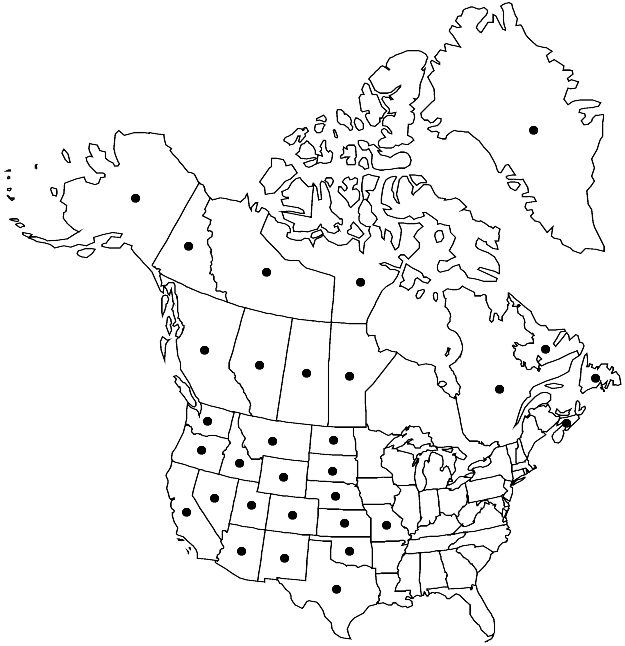Difference between revisions of "Bryum lanatum"
Muscol. Recent., suppl. 3: 20. 1817.
FNA>Volume Importer |
imported>Volume Importer |
||
| (6 intermediate revisions by 2 users not shown) | |||
| Line 7: | Line 7: | ||
|year=1817 | |year=1817 | ||
}} | }} | ||
| − | |basionyms={{Treatment/ID/ | + | |basionyms={{Treatment/ID/Basionym |
|name=Mnium lanatum | |name=Mnium lanatum | ||
|authority=P. Beauvois | |authority=P. Beauvois | ||
| + | |rank=species | ||
| + | |publication_title=Prodr. Aethéogam., | ||
| + | |publication_place=75. 1805 | ||
}} | }} | ||
|synonyms={{Treatment/ID/Synonym | |synonyms={{Treatment/ID/Synonym | ||
|name=Bryum argenteum var. lanatum | |name=Bryum argenteum var. lanatum | ||
|authority=(P. Beauvois) Hampe | |authority=(P. Beauvois) Hampe | ||
| + | |rank=variety | ||
}} | }} | ||
|hierarchy=Bryaceae;Bryum;Bryum lanatum | |hierarchy=Bryaceae;Bryum;Bryum lanatum | ||
| Line 29: | Line 33: | ||
|elevation=low to high elevations (0-4200 m) | |elevation=low to high elevations (0-4200 m) | ||
|distribution=Greenland;Alta.;B.C.;Man.;Nfld. and Labr.;N.W.T.;N.S.;Nunavut;Que.;Sask.;Yukon;Alaska;Ariz.;Calif.;Colo.;Idaho;Kans.;Mo.;Mont.;Nebr.;Nev.;N.Mex.;N.Dak.;Okla.;Oreg.;S.Dak.;Tex.;Utah;Wash.;Wyo.;Mexico;West Indies;Bermuda;Central America;South America;Eurasia;Africa;Pacific Islands (Hawaii;New Zealand);Australia;Antarctica. | |distribution=Greenland;Alta.;B.C.;Man.;Nfld. and Labr.;N.W.T.;N.S.;Nunavut;Que.;Sask.;Yukon;Alaska;Ariz.;Calif.;Colo.;Idaho;Kans.;Mo.;Mont.;Nebr.;Nev.;N.Mex.;N.Dak.;Okla.;Oreg.;S.Dak.;Tex.;Utah;Wash.;Wyo.;Mexico;West Indies;Bermuda;Central America;South America;Eurasia;Africa;Pacific Islands (Hawaii;New Zealand);Australia;Antarctica. | ||
| − | |discussion=<p>Although typically considered a variety of Bryum argenteum, B. lanatum from western North America and other parts of the world is quite distinctive. However, the type of B. lanatum from Europe may be a form of B. argenteum, in which case a new name will be needed. The species is characteristic of undisturbed native plants communities and is especially common in semiarid parts of the West on dry soil; capsules are rare. Bryum argenteum generally grows in more moist climates in highly disturbed sites, especially where there is excess nitrogen. The distribution of B. lanatum in the eastern part of North America is not well understood because the species has been combined with B. argenteum by bryologists of that region.</p> | + | |discussion=<p>Although typically considered a variety of <i>Bryum argenteum</i>, <i>B. lanatum</i> from western North America and other parts of the world is quite distinctive. However, the type of <i>B. lanatum</i> from Europe may be a form of <i>B. argenteum</i>, in which case a new name will be needed. The species is characteristic of undisturbed native plants communities and is especially common in semiarid parts of the West on dry soil; capsules are rare. <i>Bryum argenteum</i> generally grows in more moist climates in highly disturbed sites, especially where there is excess nitrogen. The distribution of <i>B. lanatum</i> in the eastern part of North America is not well understood because the species has been combined with <i>B. argenteum</i> by bryologists of that region.</p> |
|tables= | |tables= | ||
|references= | |references= | ||
| Line 38: | Line 42: | ||
-->{{#Taxon: | -->{{#Taxon: | ||
name=Bryum lanatum | name=Bryum lanatum | ||
| − | |||
|authority=(P. Beauvois) Bridel | |authority=(P. Beauvois) Bridel | ||
|rank=species | |rank=species | ||
| Line 53: | Line 56: | ||
|publication year=1817 | |publication year=1817 | ||
|special status= | |special status= | ||
| − | |source xml=https:// | + | |source xml=https://bitbucket.org/aafc-mbb/fna-data-curation/src/2e0870ddd59836b60bcf96646a41e87ea5a5943a/coarse_grained_fna_xml/V28/V28_199.xml |
|genus=Bryum | |genus=Bryum | ||
|species=Bryum lanatum | |species=Bryum lanatum | ||
Latest revision as of 21:34, 5 November 2020
Plants gregarious or in dense mats, hoary white. Stems 0.5–1(–1.5) cm, evenly foliate, weakly julaceous. Leaves erect-spreading when moist, ovate to ovate-lanceolate, somewhat concave, 0.3–1(–1.5) mm; base concolorous; margins recurved proximally, plane distally; apex acute, not cucullate, hyaline in distal 1/2 of leaf; costa long-excurrent, awn slender, hyaline, recurved when dry; proximal laminal cells quadrate or short-rectangular, 10–16 µm wide, 1–2:1; distal cells elongate-hexagonal, 40–60 × 10–16 µm, 4–5:1, walls somewhat thickened to distinctly incrassate. Specialized asexual reproduction absent. Seta brown to red-brown, 1–2 cm. Capsule brown to red-brown, ovate, (1–)2–3 mm; hypophysis differentiated, somewhat thickened and rugose. Spores 8–15 µm.
Phenology: Capsules mature May–Jul (spring–summer).
Habitat: Soil, soil over rock, rock in dry climates
Elevation: low to high elevations (0-4200 m)
Distribution

Greenland, Alta., B.C., Man., Nfld. and Labr., N.W.T., N.S., Nunavut, Que., Sask., Yukon, Alaska, Ariz., Calif., Colo., Idaho, Kans., Mo., Mont., Nebr., Nev., N.Mex., N.Dak., Okla., Oreg., S.Dak., Tex., Utah, Wash., Wyo., Mexico, West Indies, Bermuda, Central America, South America, Eurasia, Africa, Pacific Islands (Hawaii, New Zealand), Australia, Antarctica.
Discussion
Although typically considered a variety of Bryum argenteum, B. lanatum from western North America and other parts of the world is quite distinctive. However, the type of B. lanatum from Europe may be a form of B. argenteum, in which case a new name will be needed. The species is characteristic of undisturbed native plants communities and is especially common in semiarid parts of the West on dry soil; capsules are rare. Bryum argenteum generally grows in more moist climates in highly disturbed sites, especially where there is excess nitrogen. The distribution of B. lanatum in the eastern part of North America is not well understood because the species has been combined with B. argenteum by bryologists of that region.
Selected References
None.